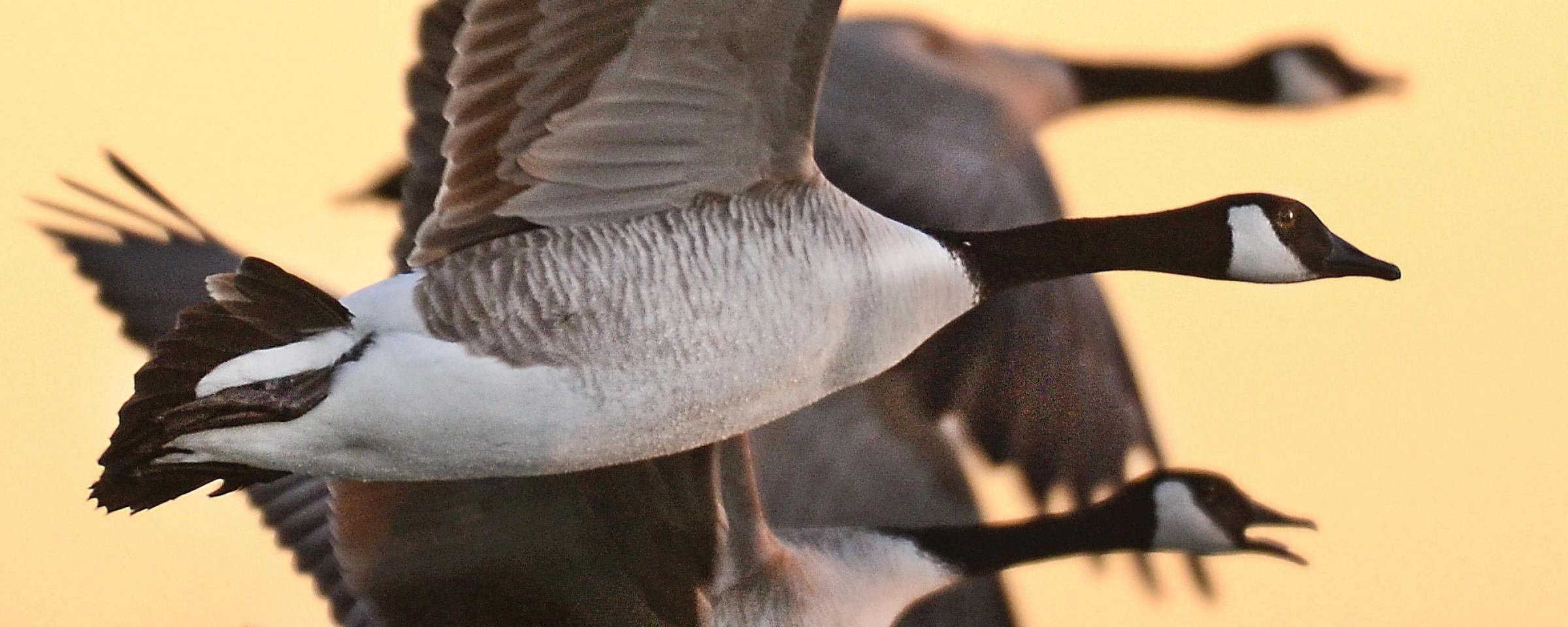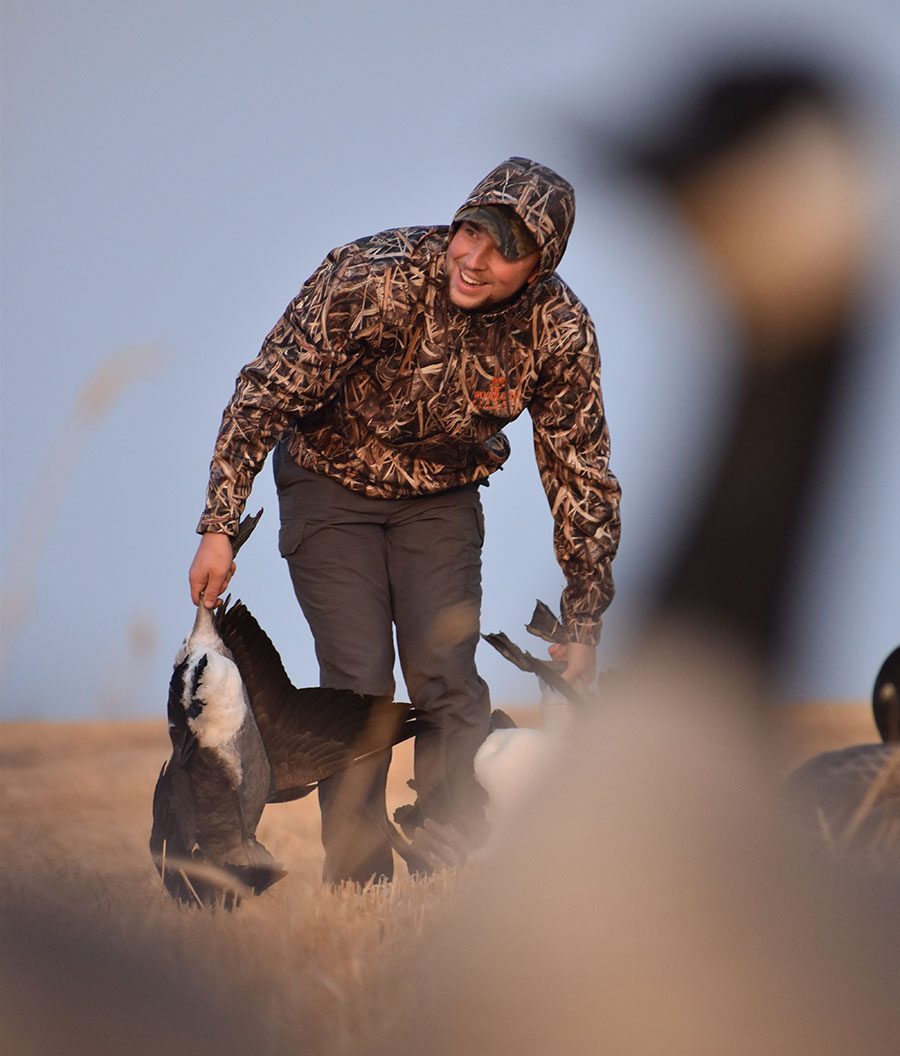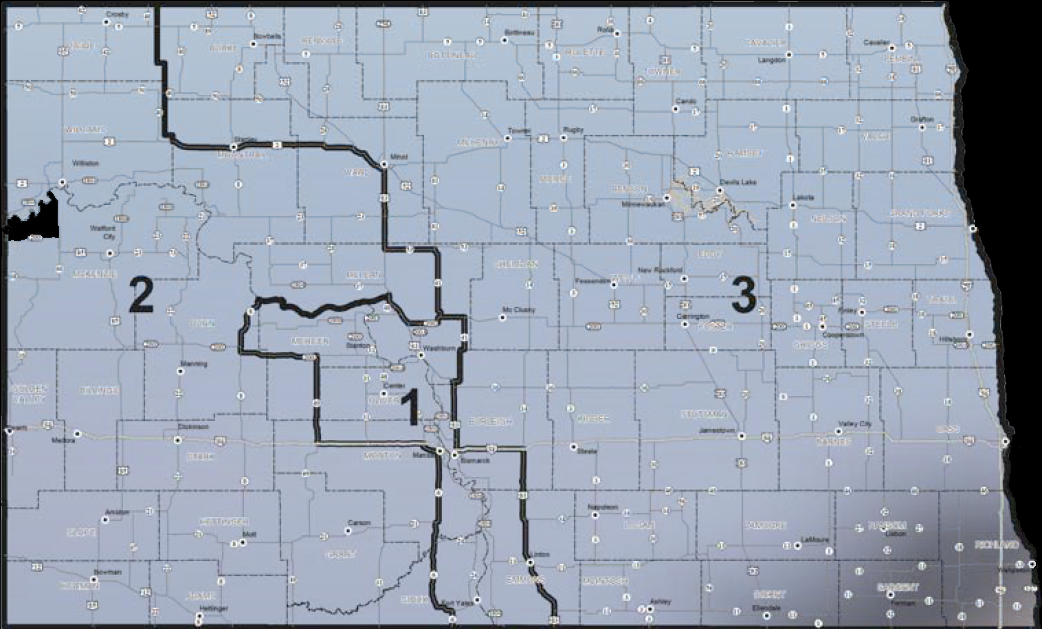
Canada Goose Hunting Zones Revised
The North Dakota Game and Fish Department has restructured the state’s Canada goose hunting zones.
According to Mike Szymanski, Department migratory game bird management supervisor, the move was made to further help address overabundant Canada geese and provide extra hunting opportunities in September, without taking away quality late-season hunting opportunities.
Under the new structure, there are now three zones – Missouri River, western and eastern – instead of two. Early Canada goose hunting opportunities open August 15 in all zones, but close on different dates (see attached sidebar), the latest being September 21 in the eastern zone.
Also, the regular Canada goose season will close in the eastern zone earlier in December than the other two zones.

John Palarski retrieves a couple of early season Canada geese shot in the Devils Lake area in 2017.
“Basically, our worst Canada goose-landowner conflicts are in the eastern half of the state and getting those extra days back in September gets some more harvest pressure on those birds,” Szymanski said. “At the same time, that part of the state doesn’t have reliable, consistent hunting opportunities late into December.”
Because the U.S. Fish and Wildlife Service allows North Dakota, which is located in the Central Flyway, a limited number (107) of days to hunt Canada geese starting September 1, waterfowl managers need to make adjustments on when to best use those days on a goose population that is above management objectives, and provide good hunting opportunities.
“To get extra days of Canada goose hunting in September, you need to take them from December,” Szymanski said. “Plus, we know that folks in the northwestern part of the state want to hunt geese later toward Christmas, which is about the time Lake Sakakawea freezes over.
“That part of the state also has some pretty good hunting in September, so we needed to make sure we left ample opportunities at that time of the year,” he added.
September Canada goose seasons started in the Central Flyway in 1999. There were concerns at the time that the seasons, which were intended for large geese, would hurt the migrant populations of small Canada geese.
Harvest surveys from 2000-02 did determine that more than 10 percent of the harvest during the September seasons in North Dakota did exceed 10 percent for small Canada geese.
“So we lost a week and were cut back to September 15 because fewer little geese were shot before that date,” Szymanski said. “A little more than a decade later, there were more big geese, and the little geese were coming to the state later.
“We worked with USFWS to take another look at the harvest survey to see if we could move back to September 22,” he added. “Indeed we could, so in 2016, the Central Flyway passed a recommendation requesting for North Dakota to get that time period back.”
The Central Flyway later passed another recommendation to allow North Dakota to issue an additional goose zone to help administer harvest on problem geese without detriment to quality late-season hunting.
“And that’s where we are in 2018,” Szymanski said. “Our spring count on Canada geese in the state was 382,000, far above our objective, but lower than if we weren’t administering additional, liberal harvest opportunities.”
Szymanski said that while Game and Fish tweaked the Missouri River zone last year in preparation to this year’s restructuring, changes such as these are not the norm.
“This is an uncommon occurrence,” he said. “We don’t plan to make changes to boundaries very often.”
Early Season
Zone 1 (Missouri River Zone)
- Opens – August 15
- Closes – September 7
Zone 2 (Western Zone)
- Opens – August 15
- Closes – September 15
Zone 3 (Eastern Zone)
- Opens – August 15
- Closes – September 21
- Daily Limit: 15
- Possession Limit: 45
- Shooting Hours: Half-hour before sunrise to sunset.
Regular Season
Zone 1 (Missouri River Zone)
- Opens – September 22 (residents), September 29 (nonresidents)
- Closes – December 28
Zone 2 (Western Zone)
- Opens – September 22 (residents), September 29 (nonresidents)
- Closes – December 21
Zone 3 (Eastern Zone)
- Opens – September 22 (residents), September 29 (nonresidents)
- Closes – December 16
- Daily Limit: 8 (Zones 2, 3); 5 (Zone 1)
- Possession Limit: 24 (Zones 2, 3); 15 (Zone 1)
- Shooting Hours: Half-hour before sunrise to: 1 p.m. CDT September 22 through November 3; 2 p.m. CST November 4 through end of season.
Extended shooting hours: Half-hour before sunrise to sunset on Saturdays and Wednesdays from September 22 through November 21; and on Saturdays, Sundays and Wednesdays from November 22 through end of season. Note: A hunter may take up to 8 Canada geese in a day, provided no more than 5 come from the Missouri River Zone. Subsequently, a hunter may possess up to 24 Canada geese, provided not more than 15 come from the Missouri River Zone.

Zone 1 (Missouri River Canada Goose Zone) – Starting where ND Highway 6 crosses the South Dakota border; then north on ND Highway 6 to Interstate 94; then west on Interstate 94 to ND Highway 49; then north on ND Highway 49 to ND Highway 200; then west on ND Highway 200; then north on ND Highway 8 to the Mercer/McLean county line; then east following the county line until it turns south toward Garrison Dam; then east along a line (including Mallard Island) along the south shore of Lake Sakakawea to U.S. Highway 83; then south on U.S. Highway 83 to ND Highway 200; then east on ND Highway 200 to ND Highway 41; then south on ND Highway 41 to U.S. Highway 83; then south on U.S. Highway 83 to Interstate 94; then east on Interstate 94 to U.S. Highway 83; then south on U.S. Highway 83 to the South Dakota border; then west on the South Dakota border to ND Highway 6.
Zone 2, (Western Zone) – Has the same boundaries as the High Plains Duck Unit, excluding the Missouri River Canada Goose Zone. Beginning at the South Dakota border, then north on U.S. Highway 83 and I-94 to ND Highway 41, then north on ND Highway 41 to ND Highway 53, then west on ND Highway 53 to U.S. Highway 83, then north on U.S. Highway 83 to U.S. Highway 2, then west on U.S. Highway 2 to the Williams County line, then north and west along the Williams and Divide county lines to the Canadian border.
Zone 3 (Eastern Zone) – Has the same boundaries as the Low Plains Duck Unit, excluding the Missouri River Canada Goose Zone. It is that portion of North Dakota east of Zone 2 (Western Zone.)
